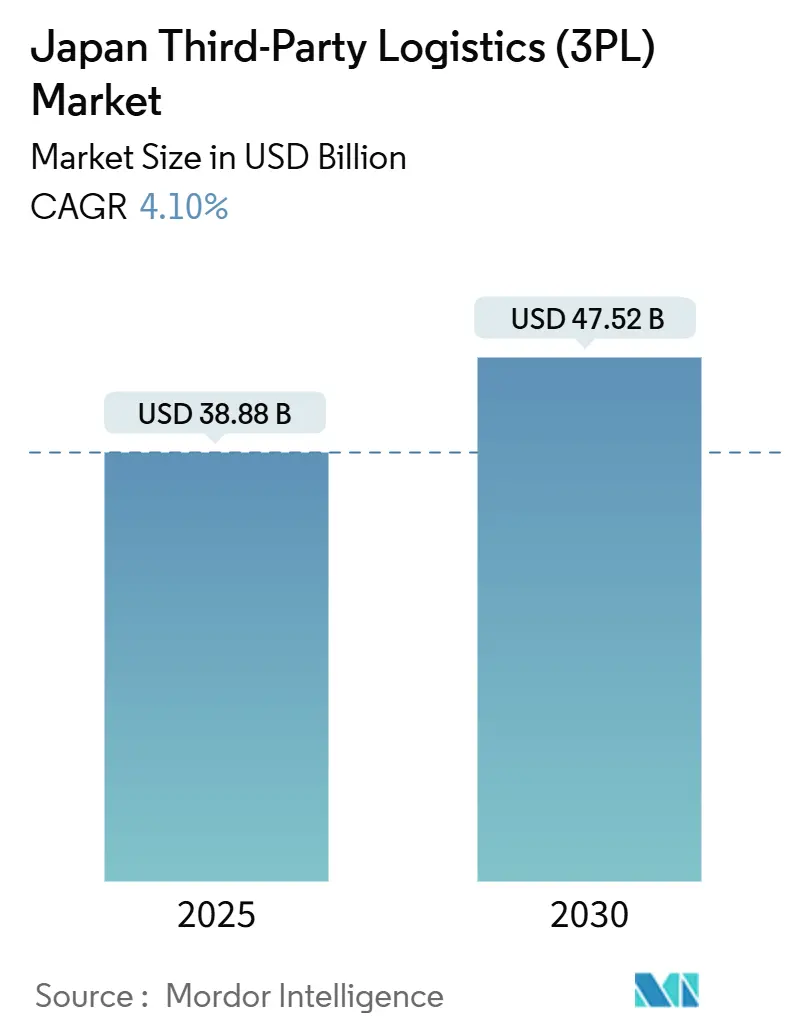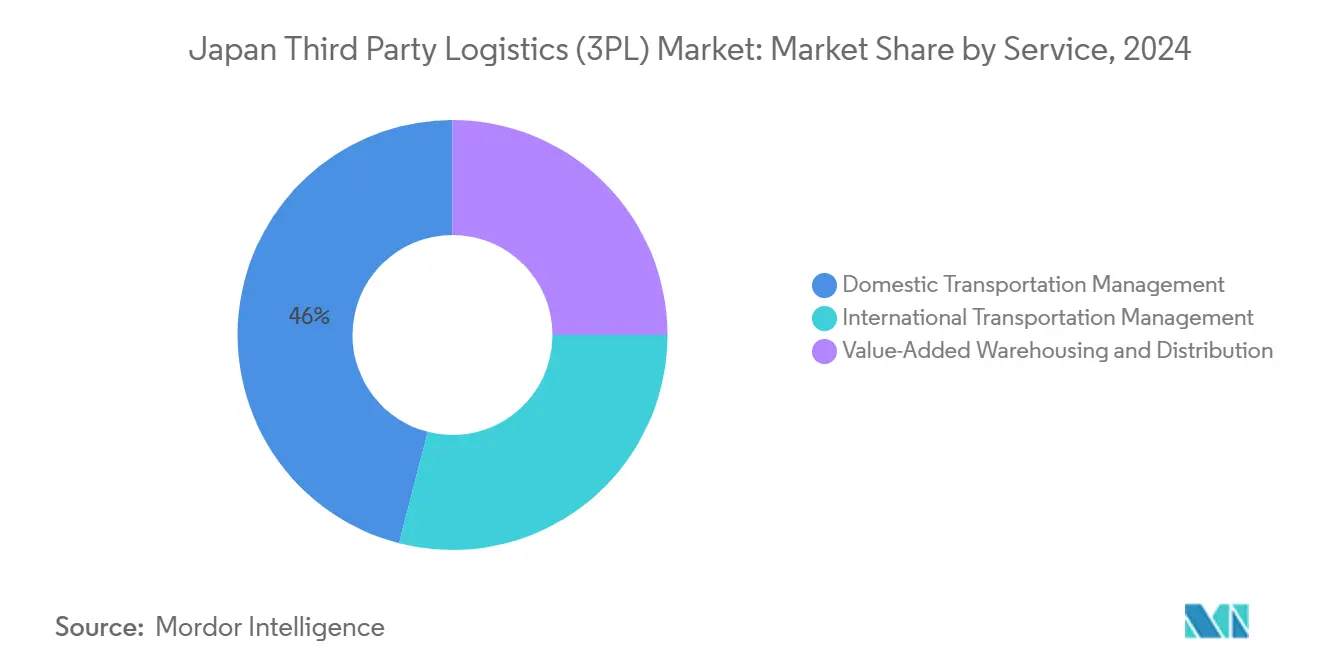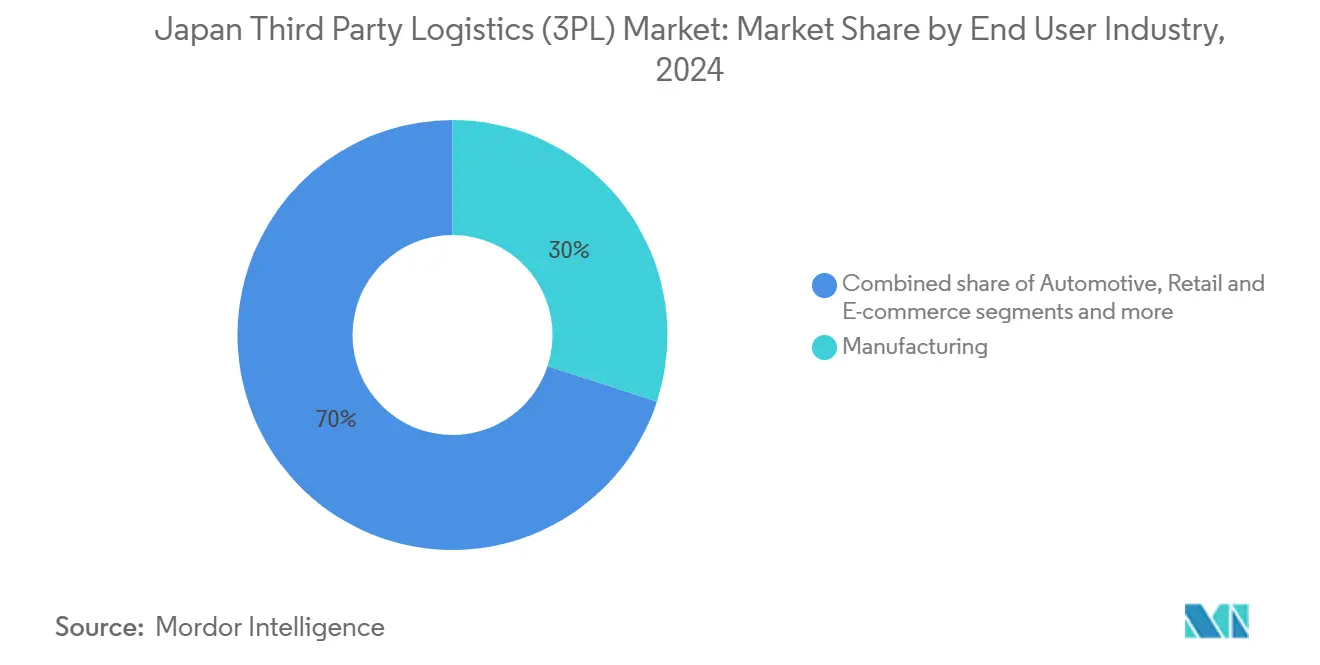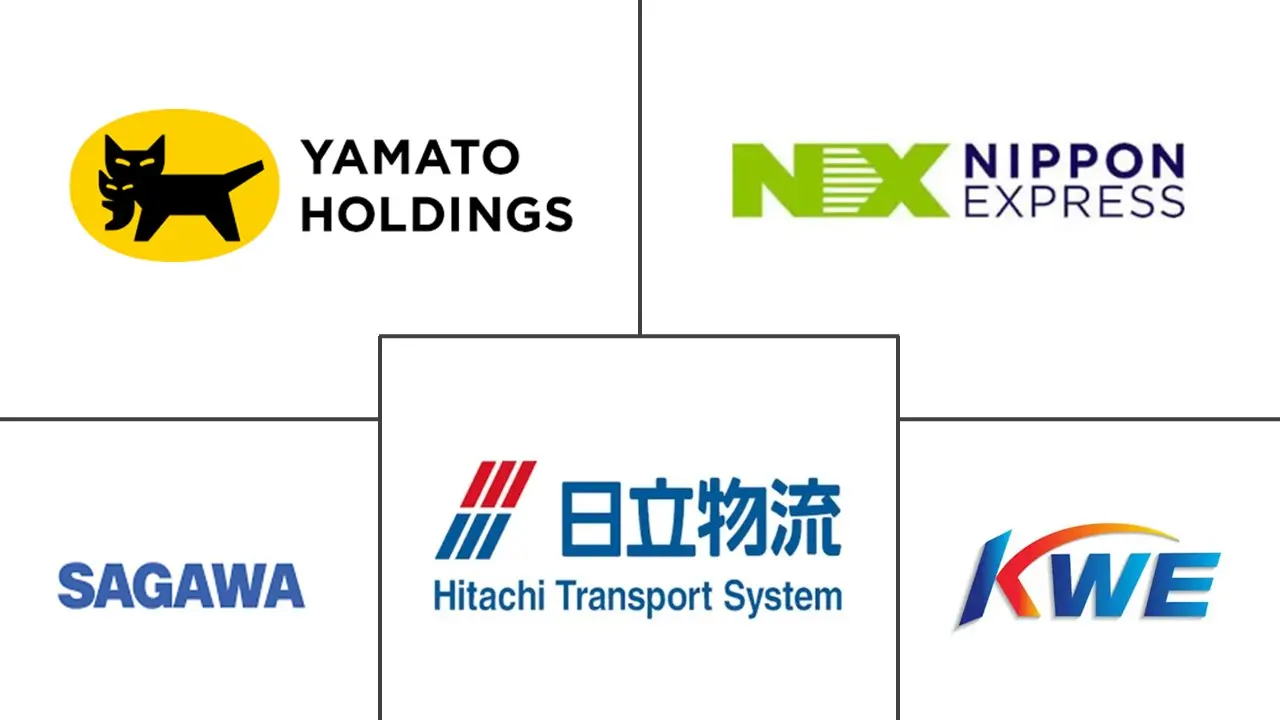
Japan Third-Party Logistics (3PL) Market Analysis by Mordor Intelligence
The Japan Third-Party Logistics Market size is estimated at USD 38.88 billion in 2025, and is expected to reach USD 47.52 billion by 2030, at a CAGR of 4.10% during the forecast period (2025-2030). New driver-overtime limits, sweeping digitalization grants, and rising decarbonization targets are forcing every logistics provider to rethink network design. Asset-heavy operators now balance automation budgets against rent inflation, while digital platforms let asset-light newcomers grow without owning fleets. Retailers, healthcare firms, and semiconductor manufacturers are asking for nationwide coverage and real-time visibility, lifting demand for integrated solutions that cut lead times and carbon footprints. As a result, the Japan 3PL market is quietly shifting from single-function transport toward data-enabled orchestration that keeps shipments moving despite deep labor and land constraints.
Key Report Takeaways
- By service, domestic transportation management held 46% of Japan 3PL market share in 2024, while value-added warehousing and distribution is expanding at a 4.52% CAGR to 2030.
- By end-user industry, manufacturing commanded 30% of Japan 3PL market size in 2024, whereas the life sciences and healthcare segment is projected to grow at a 6.08% CAGR through 2030.
- By logistics model, the asset-heavy approach retained 41% share of the Japan 3PL market size in 2024, but the asset-light model is advancing at a 4.8% CAGR over the forecast window.
- By geography, Kanto led with 68% of Japan 3PL market share in 2024; Kyushu & Okinawa is forecast to record the fastest 5.5% CAGR to 2030.
Japan Third-Party Logistics (3PL) Market Trends and Insights
Drivers Impact Analysis
| Driver | (~) % Impact on CAGR Forecast | Geographic Relevance | Impact Timeline |
|---|---|---|---|
| Same-day/next-day e-commerce culture | +1.2% | Nationwide, urban centers (Kanto 68%, Kansai 15%) | Short term (≤ 2 years) |
| National supply-chain digitalization mandates | +0.8% | National | Medium term (2–4 years) |
| Carbon-neutral commitments & modal shift | +0.7% | National, early adoption in Kanto and industrial regions | Medium term (2–4 years) |
| Supply-chain resilience & reshoring | +1.0% | National, manufacturing hubs (Chubu, Kyushu) | Medium term (2–4 years) |
| Aging consumer base & healthcare logistics | +1.1% | National, higher impact in regions with older demographics | Long term (≥ 4 years) |
| 5G & IoT roll-out tech investments | +0.6% | National, early deployment in major metropolitan areas | Medium term (2–4 years) |
| Source: Mordor Intelligence | |||
Same-Day/Next-Day E-commerce Culture Forcing Retailers Toward Nationwide 3PL Networks
Accelerating consumer demand for rapid delivery is compelling retailers to engage 3PL partners that operate distributed fulfillment nodes across the Japan 3PL market. After Yamato Transport exited Amazon’s same-day service, challengers such as Maruwa Transport committed to 10,000 new light trucks to capture the business, underscoring the opportunity for agile players. Retailers are shifting away from single-site inventory models toward multi-DC strategies that shorten final-mile distances and protect service standards despite driver-hour caps. Within densely populated metros, 3PLs now deploy micro-fulfillment centers and integrate real-time routing software to absorb demand spikes. As a result, nationwide network coverage has become a prerequisite for winning large e-commerce contracts, solidifying the strategic importance of fast-response capabilities across the Japan 3PL market.
National Supply-Chain Digitalization Mandates (Green Logistics Act & Open-API Initiatives)
Japan’s Green Logistics Act and Open-API directives are accelerating digital adoption throughout the Japan 3PL market. Public funding totaling USD 88 billion supports load-matching platforms, common data standards, and carbon-tracking tools overseen by the Ministry of Land, Infrastructure, Transport, and Tourism. Collaborative delivery pilots measure CO₂ savings that can translate into tradable credits, giving early movers a tangible incentive to share capacity and data. Leading providers are rolling out API-first transport management systems, while midsize operators join consortium platforms to access digital freight brokerage. Over the medium term, standardized data flows are expected to lift average truck load factors and partially offset the capacity loss triggered by new labor rules.
Carbon-Neutral Commitments & Emissions-Trading Pilots Driving Modal Shift to Green 3PLs
Corporate sustainability targets are redefining carrier selection criteria across the Japan 3PL market. Yamato Holdings’ “Sustainability Transformation 2030” seeks carbon-neutral parcel delivery while targeting JPY 2 trillion (USD 14.006 billion) in revenue by FY 2027[1]Yamato Holdings Co., Ltd., “Sustainability Transformation 2030 Plan,” Yamato Holdings, yamato-hd.co.jp. Yusen Logistics pledges a 45% emissions cut by 2030, reinforcing the commercial link between environmental performance and contract wins[2]Yusen Logistics Co., Ltd., “Roadmap to 45 Percent Emissions Reduction by 2030,” Yusen Logistics, yusen-logistics.com. Rail freight is resurging as Japan Freight Railway and Zen-Noh launch long-haul rice services that shift volume from road to rail[3]Japan Freight Railway Company, “JR Freight–Zen-Noh Launch Long-Haul Rice Trains,” Japan Freight Railway, jrfreight.co.jp. Such initiatives are steering modal mix decisions and elevating the competitive position of operators that can quantify and verify emissions reductions.
Reshoring & Supply-Chain Resilience Subsidies
Government grants cover up to half the cost of relocating production from a single-country supply base into domestic or ASEAN sites. Semiconductor fabs in Kyushu, battery plants in Kansai, and precision-machining clusters in Chubu demand inbound parts sequencing, clean-room storage, and black-box security protocols. These requirements create steady, high-value freight for 3PLs positioned near factories and able to run plant-to-port milk runs under tight takt times.
Restraints Impact Analysis
| Restraint | (~) % Impact on CAGR Forecast | Geographic Relevance | Impact Timeline |
|---|---|---|---|
| Truck-driver shortage & aging workforce | −0.9% | National, severe in rural areas and long-haul routes | Short term (≤ 2 years) |
| Warehouse land scarcity & rent inflation | −0.7% | Kanto region | Medium term (2–4 years) |
| Hyper-competitive last-mile market | −0.5% | National, intense competition in urban areas | Short term (≤ 2 years) |
| Cultural preference for in-house logistics | −0.4% | National, especially mid-size manufacturers in traditional industries | Long term (≥ 4 years) |
| Source: Mordor Intelligence | |||
Chronic Truck-Driver Shortage
New overtime caps slice weekly driving hours, yet delivery counts keep climbing. Four out of five carriers report open seats even after pay bumps. Robots now shuttle pallets inside depots, letting scarce drivers focus on road miles, while some firms target younger recruits through sports-based hiring drives. Despite creative fixes, the talent gap remains the single most immediate brake on growth.
Warehouse Land Scarcity & Rent Inflation
Vacancy for Grade A sheds in Greater Tokyo sits near zero, and monthly rents broke JPY 4,850 (USD 33.96) per tsubo in 2024. Developers push projects 45 km from city centers and install 40-meter-high pick towers to stretch cubic capacity. High land costs raise entry barriers for smaller 3PLs and nudge asset-heavy incumbents toward partnership, sub-leasing, or asset-light diversification.
Segment Analysis
By Service: Value-Added Warehousing Moves to the Forefront
Warehousing Space that stores and sorts now accounts for the fastest revenue line, expanding at 4.52% CAGR. Demand comes from omnichannel retailers and vaccine distributors that need temperature-zoned rooms, automated shuttles, and item-level scanning. Domestic transportation management still carries the largest volume, yet driver-hour rules and fuel volatility cap its growth. Providers that blend both—transport plus smart storage—capture higher wallet share and longer contract tenures.
Investments flow into goods-to-person robots, mezzanine pick modules, and voice-directed receiving stations. Nippon Express opened a universal design warehouse where autonomous carts free staff to handle value-adding tasks. These upgrades help operators overcome labor shortages and keep regional rents under control by squeezing more turns from every square meter.

Note: Segment shares of all individual segments available upon report purchase
By End-User Industry: Healthcare Surges Past the Pack
Manufacturing stayed the largest client cohort with 30% revenue in 2024, but life sciences and healthcare are racing ahead at a 6.08% CAGR. Japan’s elderly households now order prescription drugs and fresh meals to the doorstep, spurring demand for GDP-certified cold chain moves and fail-safe traceability. The health ministry’s Global Health Vision stresses secure medicine supply to every prefecture. Providers that run multi-temperature trucks and IoT probes grab premium margins, while semiconductor and EV battery shippers bring steady volumes that stabilize fleet utilization.

Note: Segment shares of all individual segments available upon report purchase
By Logistics Model: Asset-Light Finds New Fans
Asset-heavy fleets still dominate day-to-day coverage, holding 41% of the Japan 3PL market size, yet flexible Asset-Light or digital platforms grow quicker at 4.8% CAGR. Yusen Logistics spun its headquarters into a stand-alone management company to speed platform rollouts. Hybrid set-ups—leased line-haul, owned automation, shared cross-docks—let providers fine-tune capital exposure in a landscape of rising rents and unsettled fuel costs. Shippers reward the model that secures capacity without locking into fixed overheads.
Geography Analysis
Kanto commands 68% of current revenue, anchored by Tokyo’s consumer mass and Narita-Haneda cargo corridors. Land scarcity forces vertical builds and robotics, containing growth but preserving scale advantages. Kansai remains the second-largest cluster, marrying Osaka’s port with a dense food-processing belt that values refrigerated staging. Kyushu & Okinawa show the highest 5.5% CAGR as Taiwan-backed fabs and agro exports lift both inbound machinery and cooled outbound freight; Fukuoka’s new trade office is set to accelerate this trend.
Chubu rides automotive supply runs, while Tohoku and Hokkaido serve grains and seafood. Chugoku and Shikoku remain niche, yet specialty 3PLs win contracts in marine logistics and precision casting. Across corridors, the transport ministry’s proposed 500 km Autoflow-Road conveyor would shift palletized freight off highways and into automated lanes, illustrating how public policy tries to unlock latent capacity without more drivers.
Competitive Landscape
The Japan 3PL market hosts global majors, domestic giants, and tech-savvy boutiques. Nippon Express invested in autonomous truck firm Gatik to secure middle-mile capacity when driver supply tightens. Yamato links its carbon-neutral pledge to new aircraft routes that bypass congested roads. Kintetsu World Express diversifies into sea freight consolidation after air cargo yields softened.
Technology is the new battleground: C-Net, Lyna Logics, and Tsuzuki Electric co-develop a warehouse OS that pairs AI slotting with real-time truck ETA feeds. Chinese robotics vendors offer compact AMRs that fit Japan’s narrow aisles, squeezing extra UPH from legacy sheds. Consolidation continues: Mitsui & Co.’s buyout of HAVI Japan reinforces a trend toward vertical specialism—food, healthcare, electronics—rather than sheer volume.
Providers that publish audited carbon dashboards, run multi-temp fleets, and cover every major island will secure multi-year master contracts. Yet with the top ten firms holding only about 40% combined revenue, room remains for nimble entrants to carve profitable niches.
Japan Third-Party Logistics (3PL) Industry Leaders
-
Nippon Express Co., Ltd.
-
Yamato Holdings Co., Ltd.
-
Kintetsu World Express, Inc.
-
Sagawa Express Co., Ltd.
-
LOGISTEED, Ltd. (Hitachi Transport System)
- *Disclaimer: Major Players sorted in no particular order

Recent Industry Developments
- April 2025: Daiwa Corporation opened the 157,000 m² Chiba Yachiyo Sales Office featuring dual truck ramps for rapid turnarounds.
- April 2025: Japan GX Group teamed with LOKIAR to monetise verified CO₂ cuts from pooled deliveries.
- April 2025: C-Net, Lyna Logics, and Tsuzuki Electric began building a unified WMS that optimizes delivery routes in real time.
- October 2024: Mitsui & Co. agreed to buy HAVI Supply Chain Solutions Japan and HAVI Logistics Taiwan to bolster food-service logistics
Research Methodology Framework and Report Scope
Market Definitions and Key Coverage
Our study defines Japan's third-party logistics market as the revenue earned by independent providers that manage at least one core logistics function (domestic or international transport management, or value-added warehousing and distribution) for external customers across all prefectures. The valuation covers contractual flows inside the country and cross-border shipments that start or end in Japan.
We omit captive in-house fleets, stand-alone freight brokers without process control, and purely postal parcel services.
Segmentation Overview
- By Service
- Domestic Transportation Management
- Road
- Rail
- Air
- Inland Waterway
- International Transportation Management
- Air
- Sea
- Others
- Value-Added Warehousing and Distribution (VAWD)
- Domestic Transportation Management
- By End-User Industry
- Automotive
- Energy and Utilities
- Manufacturing
- Life Sciences and Healthcare
- Technology and Electronics
- Retail and E-commerce
- Consumer Goods and FMCG
- Food and Beverages
- Others
- By Logistics Model
- Asset-Light (Management-Based)
- Asset-Heavy (Own Fleet and Warehouses)
- Hybrid
- By Region (Japan)
- Kanto
- Kansai
- Chubu
- Kyushu and Okinawa
- Chugoku
- Shikoku
- Hokkaido
- Tohoku
Detailed Research Methodology and Data Validation
Primary Research
Interview dialogues with 3PL executives, procurement managers at manufacturers and e-commerce retailers, and regional fleet cooperatives across Kanto, Kansai, and Kyushu validated rate movements and service mix shifts. Online surveys with shippers filled the remaining information gaps.
Desk Research
We began with transport ministry freight statistics, Japan Customs trade tables, and Bank of Japan Tankan production indices, which supplied baseline shipment volumes and price markers. Association portals such as JAFA and the Japan Trucking Association offered mode splits, driver demographics, and cold-chain capacity data.
Additional intelligence came from company filings accessed through D&B Hoovers, news feeds inside Dow Jones Factiva, and automation patent trends via Questel, letting us trace cost curves and technology uptake. The sources mentioned are illustrative, and many more were reviewed for triangulation, validation, and clarification.
Market-Sizing & Forecasting
We start with a top-down build that converts national production, import, and export pools into logistics spending through mode-specific cost ratios. Supplier roll-ups of sampled contract rates multiplied by handled tonnage act as bottom-up cross-checks that refine totals. Core drivers in the model include parcel throughput, industrial output, diesel price, warehouse rent index, driver wage index, and refrigerated truck fleet count. Driver paths are forecast using multivariate regression with ARIMA overlays to catch seasonality, and scenario bands incorporate the 2024 work-hour cap and carbon levy outlook.
Data Validation & Update Cycle
Outputs undergo variance scans against external indicators, peer review by a second analyst, and a pre-release refresh whenever fuel or regulatory shocks occur. Mordor analysts revisit every dataset annually, ensuring clients always receive the most current view.
Why Mordor's Japan Third Party Logistics Baseline Commands Reliability
Published estimates often diverge because publishers mix service baskets, convert currencies differently, or freeze models for multiple years.
Our numbers stand apart since we exclude postal delivery revenue, apply live yen averages before conversion, and rebuild the model each year with direct shipper feedback.
Benchmark comparison
| Market Size | Anonymized source | Primary gap driver |
|---|---|---|
| USD 38.88 B (2025) | Mordor Intelligence | Not applicable |
| USD 66.70 B (2024) | Global Consultancy A | Includes postal and 4PL revenue, two-year-old inputs |
| USD 56.34 B (2023) | Regional Consultancy B | Relies on regional growth factor, limited Japan variables |
| USD 42.51 B (2024) | Industry Insight Firm C | Omits international legs managed by Japanese 3PLs |
Together, these contrasts show that when scope, variables, and cadence are disciplined, Mordor Intelligence delivers a balanced baseline that decision-makers can trust.
Key Questions Answered in the Report
What is the value of the Japan 3PL market in 2025?
The Japan 3PL market size is USD 38.88 billion in 2025 and is estimated to reach USD 47.52 billion by 2030.
Which service segment is expanding the fastest?
Value-added warehousing and distribution leads growth with a 4.52% CAGR, fuelled by e-commerce and cold-chain needs.
How will the 960-hour overtime rule affect logistics capacity?
Driver overtime caps are expected to cut road freight capacity by up to one-third by 2030, prompting automation and modal shift investments.
Why is Kyushu & Okinawa the fastest-growing region?
Semiconductor plant construction, cross-strait trade, and agricultural exports give Kyushu & Okinawa a projected 5.5% CAGR through 2030.
What role does sustainability play in tender awards?
Shippers increasingly require audited emissions data; 3PLs that demonstrate carbon cuts through rail freight, EV fleets, or collaborative delivery gain contract preference.
Page last updated on:



